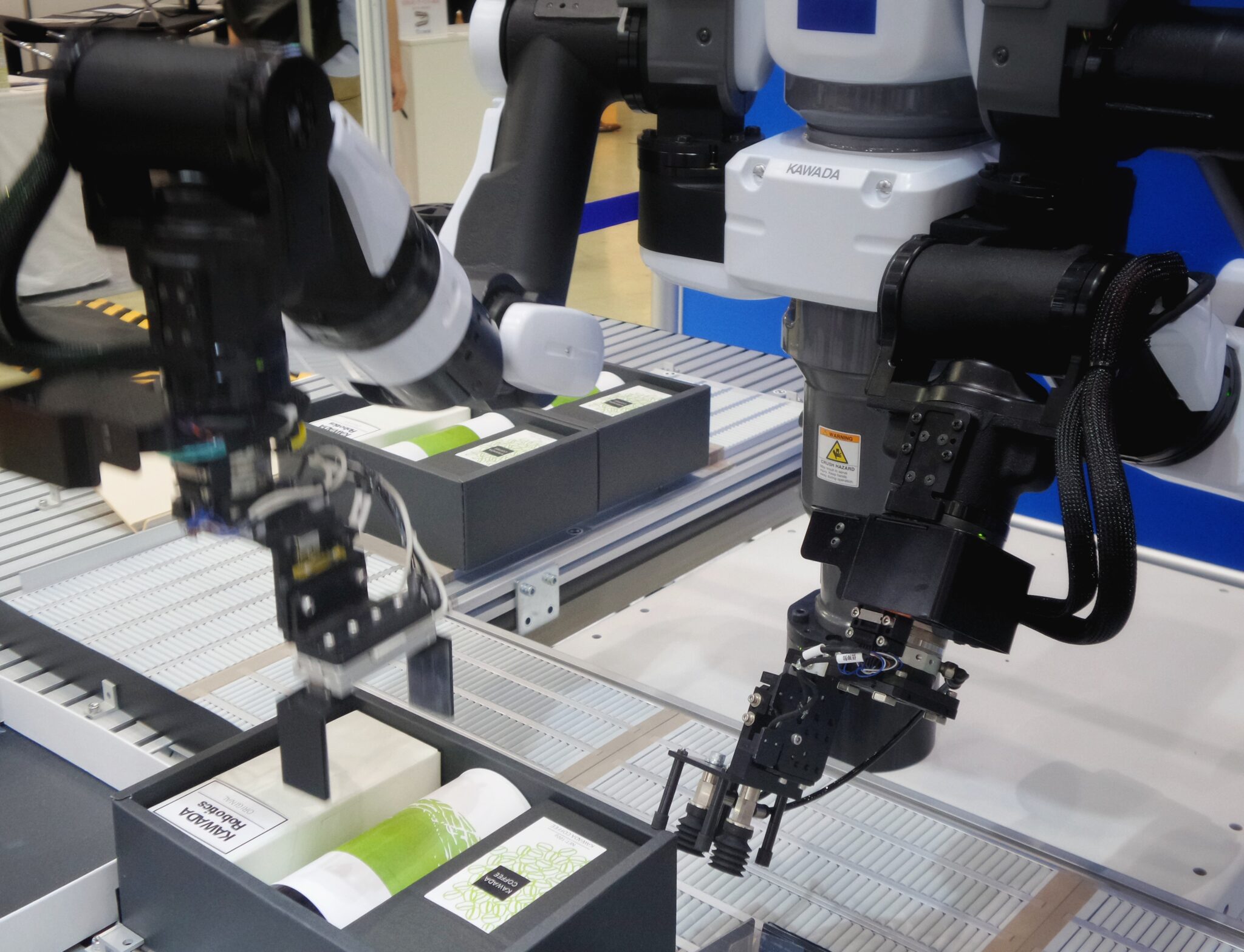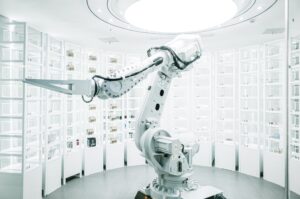
Once upon a time, manufacturing was a laborious process that involved countless hours of manual work and human error. But now, thanks to the power of artificial intelligence (AI), the industry has been transformed into a slick, streamlined machine. Imagine the possibilities when machines can think, learn, and adapt on their own? It’s no wonder AI in manufacturing is getting so much attention these days.
From optimizing production processes to enhancing efficiency with predictive maintenance, AI has become an indispensable tool for manufacturers looking to keep up with the competition. By harnessing the power of this futuristic technology, businesses can unlock a whole new level of productivity and savings. But how exactly is AI revolutionizing the manufacturing industry? Let’s dive in and find out.
The Rise of AI in Manufacturing
Have you ever heard of the term “lights out factory”? No, it’s not a factory that’s closed for business. It’s a factory that operates with almost no human intervention. With the rise of industrial automation and the advent of AI in manufacturing, the concept of a lights-out factory is no longer a pipe dream.
Industrial automation refers to the use of technology to automate manufacturing processes. With advancements in machine learning, robots have become increasingly sophisticated, replacing human workers in repetitive tasks that require precision and speed. Using AI and machine learning in manufacturing allows companies to optimize production processes and improve efficiency while reducing labor costs.
But robots replacing human workers isn’t the only way that AI is revolutionizing manufacturing. AI technologies are now being used to optimize entire production lines. With the ability to collect and analyze data from sensors and other sources, AI algorithms can identify performance bottlenecks and suggest ways to address them. This leads to better performance and increased productivity.
The Potential of Machine Learning in Manufacturing
Machine learning, a subset of AI, is particularly promising in the manufacturing industry. By analyzing data from sensors, cameras, and other sources, machine learning algorithms can predict when machinery is likely to break down, allowing for maintenance to be scheduled before failures occur. This approach, known as predictive maintenance, can help reduce downtime and save production costs.
Another area where machine learning is proving valuable is in quality control. By analyzing images and data from sensors, machine learning algorithms can detect defects more accurately than human inspectors, leading to higher-quality products.
Smart Factories and Digital Transformation
Have you ever wondered what a factory of the future would look like? Well, wonder no more because smart factories are here, and they are revolutionizing the manufacturing industry!
Smart factories use artificial intelligence and IoT devices to create intelligent, interconnected systems that can monitor and optimize production in real-time. With these systems, manufacturers can improve efficiency, cut costs, and reduce errors.
The Role of AI in Manufacturing
One of the key enablers of smart factories is AI technologies. AI makes it possible for machines to learn from data, recognize patterns, and make decisions without human intervention. This means that machines can operate more efficiently and effectively, reducing the need for human labor.
AI is also being used to create digital twins of manufacturing processes, allowing manufacturers to simulate and optimize production without disrupting actual operations. This can lead to significant cost savings and waste reduction.
In short, AI is at the heart of the digital transformation that is driving the smart factory revolution.
Why Smart Factories Matter
Smart factories are not just a buzzword; they are a necessary step in the evolution of the manufacturing industry. With rising competition and customer demands, manufacturers need to find ways to become more agile, cost-effective, and sustainable.
Smart factories enable manufacturers to achieve these goals by providing real-time data analytics, predictive maintenance, and intelligent decision-making. They also allow for greater customization and flexibility in production, ensuring that manufacturers can meet the demands of modern consumers.
The Future of Smart Factories
The potential of smart factories is vast, and their capabilities are expanding rapidly. With the integration of AI, IoT, and other emerging technologies, smart factories will continue to optimize and automate manufacturing processes.
Some of the future trends in smart factories include the use of augmented reality for employee training, 3D printing for rapid prototyping, and blockchain for secure data sharing.
As smart factories become more prevalent, we can expect to see a shift in the way manufacturing is done. With machines doing more of the work, humans will be able to focus on higher-level tasks, such as design, innovation, and problem-solving.
The future of manufacturing is smart, and it’s happening now. Are you ready to join the revolution?
Enhancing Efficiency with Predictive Maintenance
Running a manufacturing facility is no easy feat. Ensuring that all equipment is operating smoothly and efficiently is a constant battle. That’s why predictive maintenance, powered by AI and machine learning algorithms, has become a game-changer in the manufacturing industry.
Predictive maintenance uses data from various sources, including sensor readings and past equipment failures, to predict when maintenance will be necessary. This allows manufacturers to address potential issues before they become major problems and minimize downtime.
AI-driven predictive maintenance has a host of benefits. By reducing downtime, it can increase productivity and save manufacturers money in the long run. It can also help schedule maintenance more efficiently, ensuring that resources are used effectively.
But how does predictive maintenance work?
It all starts with data. Sensors throughout the manufacturing facility collect vast amounts of information, including temperature, pressure, and vibration readings. This data is fed into an AI system, which uses machine learning algorithms to identify patterns and predict when equipment may malfunction or require maintenance.
Implementing predictive maintenance does require an upfront investment in sensors and AI technology. However, many manufacturers find that the benefits outweigh the costs.
- Reduced downtime
- Increased productivity
- Cost savings
- More efficient use of resources
Overall, predictive maintenance is a powerful tool that can help manufacturers stay on top of maintenance needs and keep their facilities running smoothly. By utilizing AI and machine learning, facility managers can optimize maintenance schedules, reduce costs, and increase efficiency.
Optimizing Processes with AI in Manufacturing
Are you tired of inefficient production processes? Look no further than AI-powered solutions to optimize your manufacturing operations. From supply chain management to inventory control, AI is revolutionizing the way factories operate.
Supply Chain Management
Gone are the days of manual tracking and analysis of supply chain data. With AI, factories can now automate supply chain management, improving efficiency and reducing costs. By analyzing data on supplier performance, lead times, and inventory levels, AI algorithms can help factories make informed decisions and keep their supply chains running smoothly.
Quality Control
Say goodbye to human error in quality control with AI-powered solutions. With machine learning algorithms, factories can automatically detect defects and anomalies in production. This not only saves time, but also improves product quality and customer satisfaction.
Inventory Management
Optimizing inventory levels is crucial for any manufacturing operation. With AI, factories can predict demand and optimize inventory levels to prevent excess stock. This reduces waste and saves money in the long run.
Overall, the implementation of AI-driven solutions in manufacturing processes offers numerous benefits, including increased efficiency, reduced costs, and improved product quality. Don’t miss out on the benefits of process optimization with AI.
Robotics in Manufacturing
Robots are no longer just a staple of sci-fi movies and space exploration. They are now integral to the manufacturing industry, with the integration of AI technologies taking their abilities to the next level.
AI-driven robots are transforming the manufacturing landscape, improving efficiency and productivity. These robots can perform a range of tasks, including assembly, welding, painting, and packaging, with great accuracy and speed.
One of the most significant benefits of robotic systems integrated with AI technologies is the reduction in human labor requirements. Robots can work around the clock, without the need for breaks or rest, which means that factories can increase production without having to hire additional human staff.
AI-Driven Robotics
The integration of AI technologies in robots has unlocked new capabilities, making them more flexible and adaptable than ever before. These robots can learn from their environment, develop new strategies, and make decisions based on data, all in real-time.
With machine learning algorithms, these robots can determine the most efficient way to perform a task. They can even learn from their mistakes, making them more accurate and effective with each iteration.
The Future of Robotics in Manufacturing
As AI technologies continue to improve, we can expect to see a greater level of integration between robotic systems and the other technologies used in manufacturing. This will lead to even more efficient and productive factories, with the potential to revolutionize the industry.
One of the biggest challenges facing the industry is the shortage of skilled workers. With the integration of AI-driven robotics, the industry can reduce its reliance on human labor and mitigate the impact of this shortage.
- Robots are changing the manufacturing landscape, improving efficiency and productivity.
- AI-driven robots are flexible and adaptable, capable of learning and making decisions based on data.
- The integration of robotic systems with AI technologies will lead to even greater efficiency and productivity in the future.
With the integration of AI-driven robotics, the manufacturing industry is entering a new era of efficiency and productivity. As robots become more sophisticated, they will continue to replace human labor in many areas, leading to a significant transformation of the industry.
FAQ: AI in Manufacturing
Still have some questions about AI in manufacturing? Don’t worry, we’ve got you covered!
What is AI in manufacturing?
AI in manufacturing refers to the use of artificial intelligence technologies to improve and automate various aspects of the manufacturing process. This can include everything from production and quality control to supply chain management and predictive maintenance.
How is AI transforming the manufacturing sector?
AI is transforming the manufacturing sector by enabling greater automation, optimization, and efficiency. By leveraging machine learning algorithms and other AI-driven technologies, manufacturers can optimize their processes and reduce costs while also improving product quality.
What types of AI technologies are being used in manufacturing?
Some of the most commonly used AI technologies in manufacturing include machine learning, computer vision, natural language processing, and predictive analytics. These technologies can help manufacturers automate and optimize a wide range of processes, from quality control to supply chain management.
What are some benefits of using AI in manufacturing?
Using AI technologies in manufacturing can provide a wide range of benefits, from reducing labor costs and improving efficiency to preventing costly equipment failures and improving product quality. Ultimately, the use of AI in manufacturing can help companies stay competitive and adapt to changing customer needs and market conditions.
Are there any downsides to using AI in manufacturing?
While there are certainly many benefits to using AI in manufacturing, there are also some potential downsides to consider. For one, the use of AI technologies can be expensive and requires significant investment in both hardware and software. Additionally, there is always the risk that something could go wrong with an AI-driven system, which could lead to errors or other unexpected outcomes.
How can companies get started with AI in manufacturing?
The best way for companies to get started with AI in manufacturing is to first assess their needs and identify potential areas where AI could have a significant impact. From there, they can work with a provider to develop and implement AI-driven solutions that meet their specific needs and goals.






